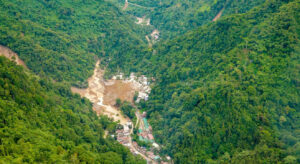The landslide that happened on Feb. 6 in Maco, Davao de Oro was most unfortunate. Continuous heavy rains poured into the area due to the northeast monsoon and a trough of low-pressure that affected the Davao Region, northern Mindanao, Caraga, and BARMM.
We condole and commiserate with the families of those who perished, and with entire communities that have been devastated by the tragedy.
In a time of grief, we look for some consolation. In the landslide’s aftermath, we observed how the local government unit, the private sector — specifically Apex Mining, the company operating in the area — and the local community have been working together in the spirit of bayanihan (communal unity and cooperation). Survivors in the community are helping in the search and rescue operation. Apex Mining, despite being allowed to continue mining operations, has, out of its own volition, limited its normal operations so it could fully support the provincial government of Davao de Oro in its rescue efforts and focus on the needs of the people, though outside of the area in which it operates.
Unfortunately, the incident has also prompted some groups to play the blame game, pointing to “destructive” mining operations and, specifically, Apex Mining, for the tragedy. But the Department of Environment and Natural Resources itself already said that the landslide was caused by “natural” circumstances triggered by weeks of heavy rain and the incident happened in a residential area that is outside of the Apex mining site.
The speculation and finger pointing that have been happening are counterproductive to the entire objective of addressing the immediate need for rescue, enabling the community to recover from the tragedy, and making it resilient to future disasters.
RESPONSIBLE MININGThe environmental impact of mining operations has been an age-old controversy that has been addressed by great advances in technology, and strict regulation to ensure responsible mining practice. By virtue of the existence of mining laws in our country, it has been established and accepted that mining could be good for the country, if it is done responsibly.
Foremost, mining contributes to local economic growth. Responsible mining companies play a significant role in driving local economic growth by creating employment opportunities, fostering business development, and investing in community infrastructure and services. All these happen in very remote areas that otherwise would remain undeveloped.
By promoting local entrepreneurship and providing sustainable livelihood opportunities, mining companies contribute to poverty reduction and socioeconomic empowerment, enabling communities to become more resilient in the face of challenges.
Second, mining companies play a role in local community disaster response. During times of disaster, mining companies can leverage their resources and expertise to swiftly respond to emergencies, offering essential aid such as food, shelter, medical supplies, and logistical support.
This was exactly what the Davao de Oro incident showed. In the event of disasters, mining companies together with other private firms, can use whatever is at their disposal to respond promptly and effectively to emergencies. Irrespective of their geographical location, private companies can collaborate and pool their resources to initiate a collective effort in times of disaster. Despite being from different regions, mining companies extended their support and assistance to the affected community.
The collaborative effort among mining companies underscores the importance of collective action and partnership in addressing complex challenges and crises. By working together, these companies are able to maximize their impact and coordinate their efforts more efficiently, ultimately contributing to more effective disaster response and recovery efforts.
Finally, mining companies contribute to sustainable and climate resilient local infrastructure. They are able to do this through their Social Development and Management Program (SDMP), which serves as a key mechanism for fostering community development and addressing environmental and social concerns. Projects under this program are designed to align with the United Nations’ Sustainable Development Goals (SDGs). By investing in climate-resilient infrastructure projects through their SDMP, mining companies contribute to the achievement of SDGs related to climate action (SDG 13) and sustainable cities and communities (SDG 11).
Climate change and the increasing frequency of natural disasters highlight the urgent need for climate and disaster-resilient infrastructure. Meanwhile, mining industry-led climate and disaster-resilient infrastructure would help mitigate risks associated with climate change by reducing their host communities’ vulnerability. By incorporating climate data and projections into infrastructure planning and design, communities can identify potential risks and implement measures to enhance resilience.
There are several lessons learned from this tragic landslide. Barangay Masara, where the landslide happened, is considered a danger zone. However, the Office of Civil Defense — Davao region chief said people still preferred to live here for its proximity to their work. The disaster risk reduction management officer said people had already been relocated to another place but eventually returned.
It is but natural for people to want to live close to their livelihood — provided, of course, that they are aware of the risks and there are safety and disaster response protocols in place. This serves as a challenge for LGUs on how they should ensure the safety of their citizens who persist in living and working in hazard zones within their jurisdiction.
Victor Andres “Dindo” C. Manhit is the president of the Stratbase ADR Institute.
